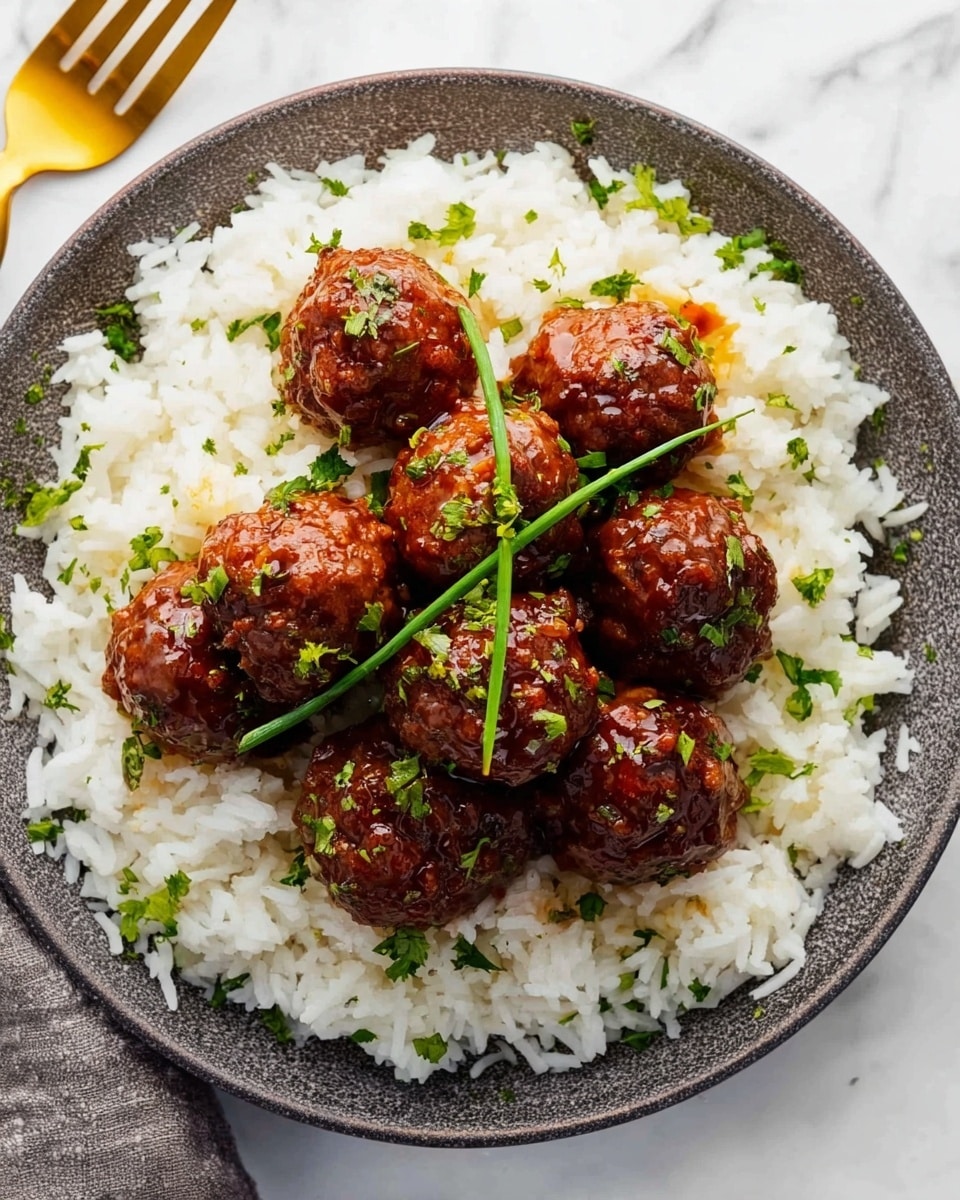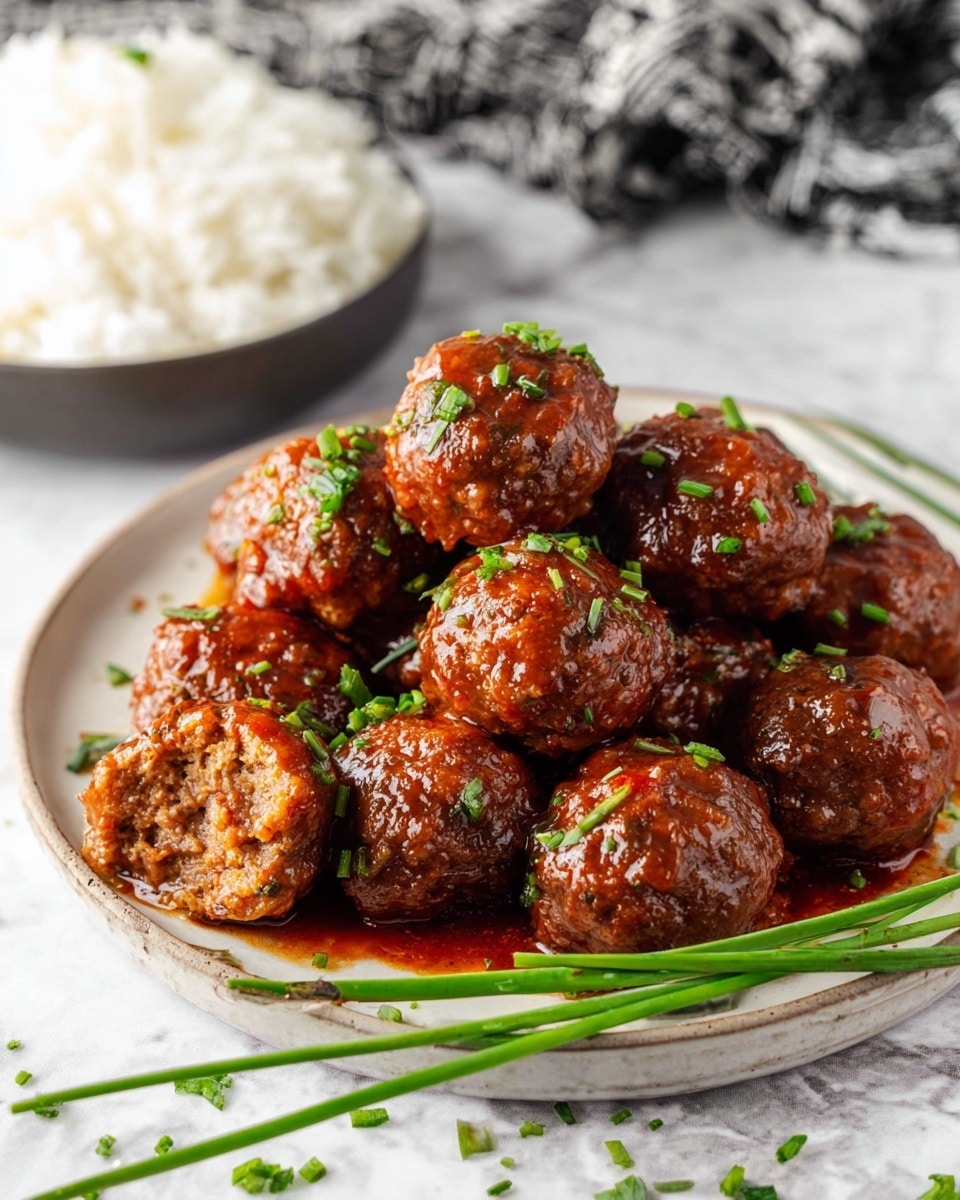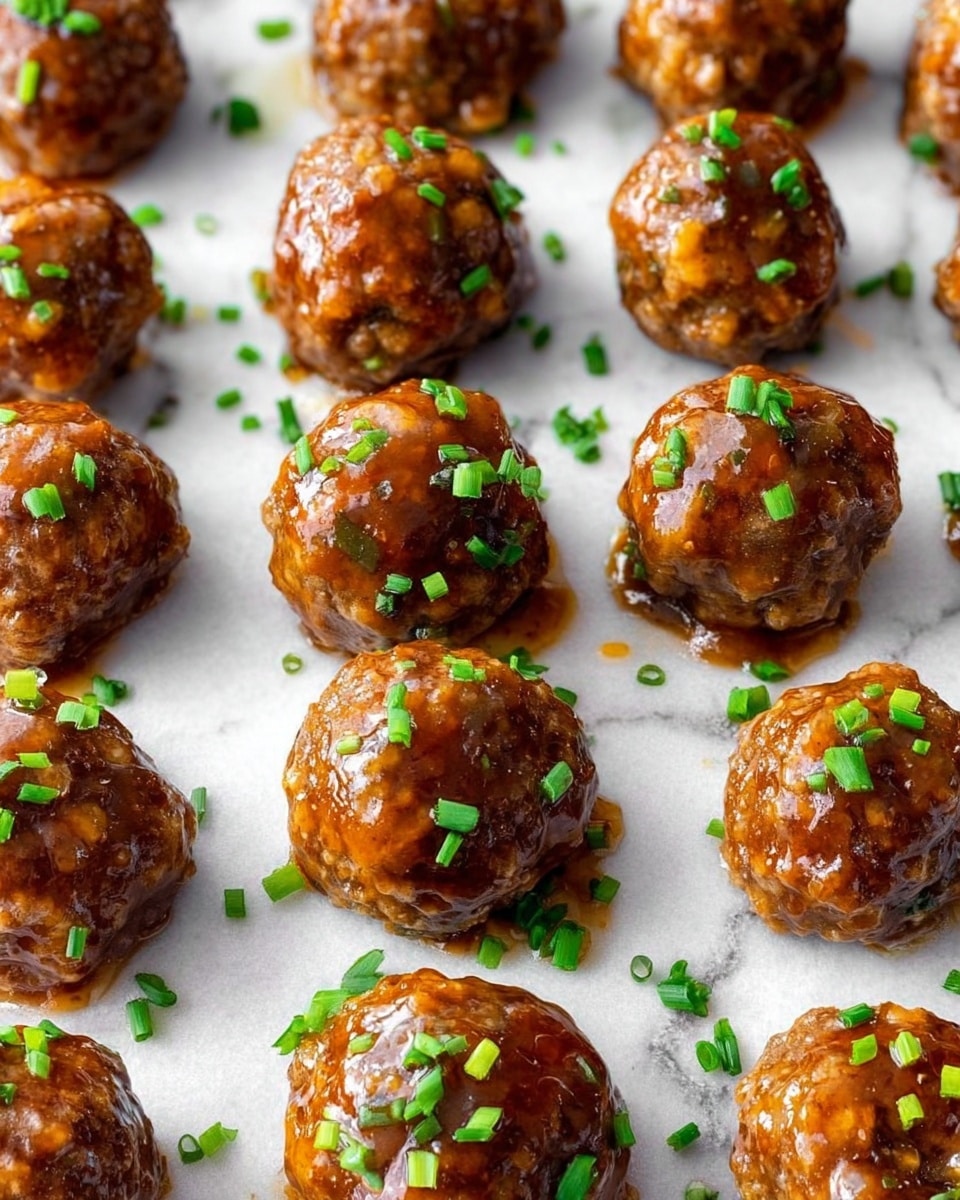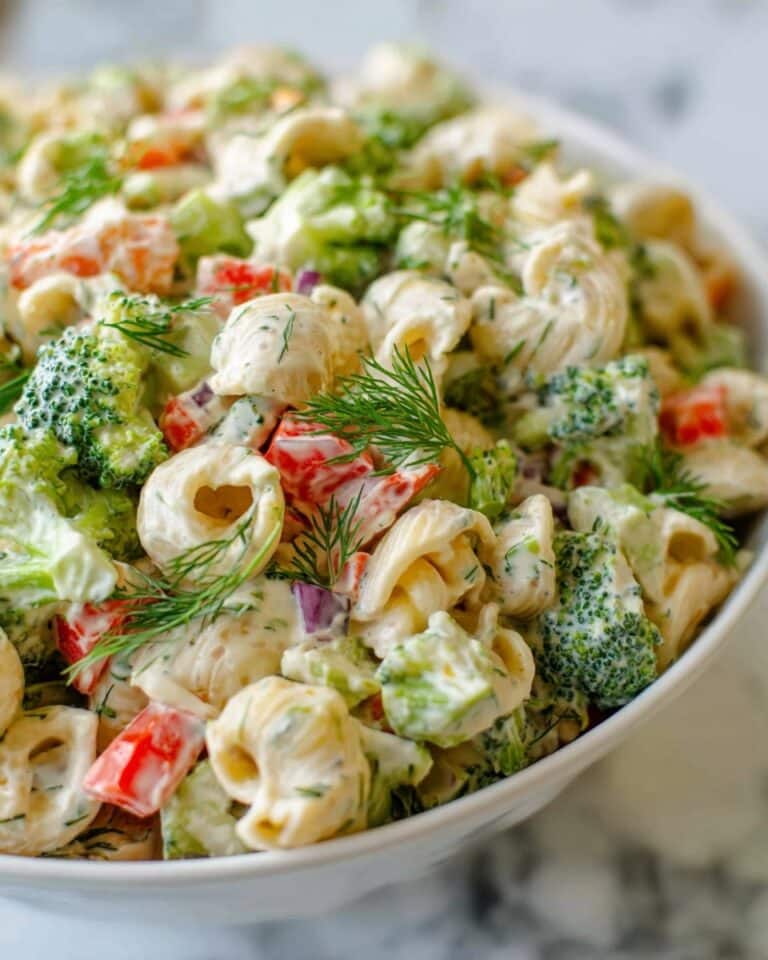Korean Meatballs with Spicy Apricot Glaze Recipe
If you’re looking for a dish that’s bursting with bold, memorable flavors but still easy enough for a weeknight, I’ve got you covered. This Korean Meatballs with Spicy Apricot Glaze Recipe is one of my go-to recipes when I want something a little adventurous but totally comforting. The sweet and spicy apricot glaze paired with the savory, garlicky meatballs creates a harmony that’s simply irresistible.
What makes this recipe truly special is its versatility—you can serve these meatballs as a fun appetizer at a party or pile them over rice for a satisfying dinner that feels both homey and exotic. Plus, they’re straightforward enough that you can whip them up without stress, even if Korean flavors feel new to you.
Why This Recipe Works
- Balanced Flavors: The spicy heat from Gochujang perfectly complements the sweet apricot glaze for an addictive taste.
- Simple Prep: It uses pantry staples but delivers a complex, restaurant-worthy flavor with minimal effort.
- Versatile Serving: Great as an appetizer, party snack, or main course over rice or noodles.
- Crowd-Pleaser: The meatballs are bite-sized and easy to enjoy, making them a hit with kids and adults alike.
Ingredients & Why They Work
This Korean Meatballs with Spicy Apricot Glaze Recipe works so well because the ingredients blend textures and flavors that complement each other perfectly. From the lean beef to the tangy Gochujang paste, each component brings its own delicious contribution.
- Lean ground beef: Using lean beef helps keep the meatballs moist without being too greasy.
- Green onions: They add fresh brightness and a mild onion crunch that cuts through the richness.
- Breadcrumbs: Panko or regular, they help bind the meatballs and keep them tender.
- Garlic: Fresh garlic amps up the savory flavor base.
- Egg: Acts as a binder and gives structure to the meatballs.
- Gochujang paste: This Korean chili paste brings a smoky, spicy kick that defines the dish.
- Ground ginger: Adds warmth and subtle earthiness without overpowering.
- Salt and pepper: Essential for seasoning and highlighting the other flavors.
- Apricot jam: Provides the sweet contrast in the glaze to balance the heat.
- Soy sauce: Adds umami depth and a touch of saltiness in the glaze.
Make It Your Way
I like to experiment a bit with this Korean Meatballs with Spicy Apricot Glaze Recipe depending on what I have on hand or the vibe I want. It’s a recipe that invites you to play with spice levels or even swap proteins without sacrificing the soul of the dish.
- Variation: Sometimes I swap beef for ground turkey or chicken when I want something lighter, and it turns out just as tasty.
- Spice adjustment: If you want it milder, go easy on the Gochujang or substitute with Sriracha at a lower ratio.
- Glaze twist: I’ve swapped apricot jam for orange marmalade to add a slightly different citrusy sweetness that pairs marvelously.
- Serving style: Feel free to turn these into sliders by placing meatballs on mini buns with some crunchy slaw.
Step-by-Step: How I Make Korean Meatballs with Spicy Apricot Glaze Recipe
Step 1: Mix and measure your ingredients
I start by gathering all my ingredients because it makes the process smoother. Then, I toss the ground beef, chopped green onions, breadcrumbs, minced garlic, egg, Gochujang, ground ginger, salt, and pepper into a big mixing bowl. I use my hands to gently but thoroughly combine everything—this helps me feel when the mixture is evenly blended without overworking the meat, which keeps the meatballs tender.
Step 2: Shape the meatballs evenly
Using a small cookie scoop is a game changer—it guarantees all meatballs are the same size, so they cook evenly. I scoop out about 1-inch balls and place them on a parchment-lined baking sheet, leaving just a bit of space between each meatball. This step keeps things neat and avoids uneven cooking. If you don’t have a scoop, just use your hands, but try to keep the sizes consistent.
Step 3: Bake until juicy and cooked
I bake the meatballs at 400°F (about 200°C) for 20 to 25 minutes, but I always keep an eye on them after 20 minutes. The key is to bake until they reach an internal temperature of 160°F (74°C)—an instant-read thermometer helps here. Overbaking can dry them out, so check early if your oven runs hot. The meatballs should be browned but still juicy inside.
Step 4: Toss in the spicy apricot glaze
While the meatballs bake, I whisk together apricot jam, soy sauce, and more Gochujang in a bowl to create that finger-licking spicy apricot glaze. As soon as the meatballs come out of the oven, I gently toss them in the glaze so every bite gets coated with that sticky-sweet-spicy goodness. This step really elevates the whole dish and leaves you wanting more.
Tips from My Kitchen
- Taste Before You Roll: I like to cook a tiny spoonful of the meat mixture first to test the seasoning, so I’m sure the flavor is spot on before rolling a whole batch.
- Don’t Overmix: Mixing just until combined avoids dense meatballs; I learned this the hard way!
- Use a Cookie Scoop: It makes meatball sizes uniform and speedier to shape, which helps them cook evenly.
- Glaze Gently: Toss the meatballs carefully in the glaze to keep them intact and glossy.
How to Serve Korean Meatballs with Spicy Apricot Glaze Recipe

Garnishes
I love sprinkling freshly chopped green onions or chives over the glazed meatballs—it adds a fresh pop of color and a mild, herbal bite that’s irresistible. Toasted sesame seeds are another favorite garnish, giving a subtle nuttiness and a little crunch.
Side Dishes
This dish pairs wonderfully with simple steamed jasmine rice or sticky rice to soak up the glaze. I often serve it alongside quick sautéed greens like bok choy or spinach to add a fresh, healthy vibe. Pickled vegetables or kimchi make an excellent tangy contrast as well.
Creative Ways to Present
For parties, I’ve set these meatballs up on skewers or toothpicks, making them perfect finger food. Another idea I tried recently was layering them in sliders with crunchy slaw and a drizzle of Sriracha mayo—it was a total crowd-pleaser! Even served over cold noodles for a summer picnic, they make quite the statement.
Make Ahead and Storage
Storing Leftovers
I cool leftover meatballs completely, then store them in an airtight container in the fridge. They keep well for up to 4 days—perfect for quick lunches or dinner the next day. Make sure to keep the glaze separate if you want them less sticky initially.
Freezing
Freezing works great for this Korean Meatballs with Spicy Apricot Glaze Recipe. After baking and glazing, I let the meatballs cool, then place them in a single layer on a baking sheet to flash freeze before transferring to freezer bags. They freeze well for up to 3 months and are excellent for meal prep.
Reheating
To reheat, I prefer warming them gently in a skillet over medium heat with a splash of water to keep them moist. Microwaving works in a pinch, but you might lose a bit of that fresh-baked texture. Reheat slow and steady to keep them juicy and flavorful.
FAQs
-
Can I make Korean Meatballs with Spicy Apricot Glaze Recipe gluten-free?
Absolutely! Just swap the regular breadcrumbs for gluten-free breadcrumbs and make sure your soy sauce is gluten-free (tamari is a great alternative). Everything else in the recipe is naturally gluten-free.
-
What if I don’t have Gochujang paste? Can I substitute it?
You can use Sriracha or another chili paste in place of Gochujang; just be aware that the flavor will be different since Gochujang has a unique fermented, slightly sweet depth that adds character. Adjust the amount to your preferred spice level.
-
How do I know when the meatballs are fully cooked?
The safest way is to use an instant-read thermometer. The internal temperature should reach 160°F (74°C). If you don’t have one, cut a meatball in half to check that it’s no longer pink inside.
-
Can I use other meats instead of beef?
Yes! Ground chicken, turkey, or pork all work well. Just keep in mind that lean meats might dry out faster, so watch your cooking time and consider adding a bit of olive oil or fat if needed.
Final Thoughts
Honestly, this Korean Meatballs with Spicy Apricot Glaze Recipe has become a staple in my kitchen because it hits that perfect balance between comfort food and something just a bit unexpected. I hope it brings that same joy and ease to your table that it does to mine. Give it a try—you might just find your new favorite way to enjoy meatballs!
Print
Korean Meatballs with Spicy Apricot Glaze Recipe
- Prep Time: 15 minutes
- Cook Time: 30 minutes
- Total Time: 45 minutes
- Yield: 36 meatballs
- Category: Appetizer
- Method: Baking
- Cuisine: Korean
Description
Delicious Korean Meatballs made with ground beef, seasoned with garlic, ginger, and Gochujang paste, baked to perfection and glazed with a spicy apricot sauce. Perfect as an appetizer or served over rice for a flavorful meal.
Ingredients
For Meatballs
- 1½ pound lean ground beef
- 4 green onions (chopped)
- ½ cup breadcrumbs (such as Panko)
- 3 cloves garlic (minced)
- 1 egg
- 2 tablespoons Gochujang paste (or Sriracha)
- 1 teaspoon ground ginger
- 1 teaspoon salt (or to taste)
- ½ teaspoon pepper (or to taste)
For Spicy Apricot Glaze
- ½ cup apricot jam
- 1 tablespoon soy sauce
- 2 tablespoons Gochujang paste (or Sriracha)
Instructions
- Preheat Oven: Preheat oven to 400°F. Line a baking sheet with parchment paper and set aside to prepare for baking the meatballs.
- Mix Meatball Ingredients: In a large bowl, combine ground beef, chopped green onions, breadcrumbs, minced garlic, egg, Gochujang paste, ground ginger, salt, and pepper. Mix together thoroughly with your hands until everything is evenly combined.
- Form Meatballs: Shape the mixture into small 1 inch meatballs. Place them evenly spaced on the prepared baking sheet to ensure even cooking.
- Bake Meatballs: Bake the meatballs in the preheated oven for 25 minutes or until cooked through and browned to your liking. You may check doneness with a meat thermometer ensuring an internal temperature of 160°F (74°C).
- Prepare Glaze: While meatballs bake, whisk together apricot jam, soy sauce, and Gochujang paste in a medium bowl until smooth and combined.
- Glaze Meatballs: Once meatballs are cooked, transfer them to the bowl with the glaze and toss gently to coat all meatballs evenly with spicy apricot sauce.
- Serve: Garnish with chopped chives if desired. Serve immediately over cooked rice or as an appetizer for a flavorful experience.
Notes
- This recipe yields about 36 meatballs depending on size.
- You can substitute ground beef with ground chicken, turkey, or pork as preferred.
- Orange marmalade can be used as an alternative to apricot jam.
- Use an instant-read meat thermometer to ensure meatballs reach a safe internal temperature of 160°F (74°C).
- Taste a small portion of meat mixture cooked prior to forming meatballs to adjust seasoning if needed.
- Using a cookie scoop helps to portion meatballs evenly for uniform cooking.
Nutrition
- Serving Size: 1 meatball
- Calories: 70 kcal
- Sugar: 3 g
- Sodium: 150 mg
- Fat: 4 g
- Saturated Fat: 1.5 g
- Unsaturated Fat: 2.5 g
- Trans Fat: 0 g
- Carbohydrates: 5 g
- Fiber: 0.3 g
- Protein: 5 g
- Cholesterol: 25 mg









